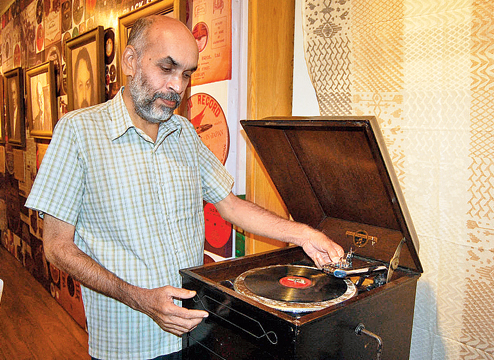
If you have inherited a collection of old gramophone records you have no idea how to preserve or perhaps even where to play, this is the address where to head. Weavers Studio Centre for the Arts has opened a digitising centre in its gallery space in Ballygunge Place where old and rare records are being digitised.
“We want collectors to come forward. We will digitise and archive their records and return the discs to them along with a CD of what we archived. We have started with 400 records and can digitise two records per day,” said founder Darshan Shah. Early 20th century single-sided cardboard Nicole, shellac Pathe, paper records and pre-World War I Beka-Grand records form part of their acquisition, sourced from flea markets. “We are working on a wide range of genres — Hindustani and Carnatic classical, folk, early film or theatre music, Bengali songs and speeches of leaders,” Shah added.
The centre wishes to disseminate the digitised content among music lovers and researchers through audio-visual exhibitions, listening kiosks and portals, guided listening sessions etc. It has set up a permanent listening facility for visitors to enjoy the digitised sound, on two computers with headphones and 10 Android phones gifted by Tata Docomo. On each phone, close to 150 audio clips have been uploaded, which are being changed depending on the theme of the exhibition organised most recently by the centre. “We can take the phones to schools or to other cities when we hold travelling exhibitions,” Shah said.
Schools are also being invited to send students over to experience India’s audio history. One can walk in and listen to any of the digitised material like the “Tryst with destiny” speech of Jawaharlal Nehru or Swami Vivekananda’s Chicago address, or voices of Subhas Chandra Bose and Mahatma Gandhi. There are also 70 versions of Vande Mataram. The listening facility is available on weekdays, 3pm to 7pm.
The centre was inaugurated by Suresh Chandvankar, the secretary of the Society of Indian Record Collectors in Mumbai. “In Calcutta, where India’s first commercial recording was done in 1902 by Gauhar Jaan for The Gramophone Company, there are people with knowledge in the field but not many are ready to come forward and share it. This is the first time that a digital archive is being set up and exhibitions on records being held by a private body unsupported by the government,” said Chandvankar, who has bought an apartment on the outskirts of Mumbai just to store his collection of records.
Even after a record has been digitised, Chandvankar argues for its preservation. “Digital can never replace the physical form. When a new technology comes, the physical recording will be needed again.”
The future of preservation, he believes, is a virtual archive. “Put all digital material on Cloud. And for outreach, the best channel is social media,” he advised. “But when it comes to sound quality, aficionados abroad are getting tired of the digital sound. So a revival of the disc is on the cards. In fact, many of my collector friends believe that the 78 rpm disc has the best sound quality.”
source: http://www.telegraphindia.com / The Telegraph, Calcutta / Front Page> Calcutta> Story / by Sudeshna Banerjee / Sunday – November 16th, 2014








